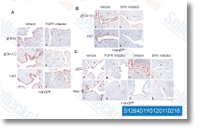In colo rectal cancer EpCAM seems to act as molecule with protective function, considering the fact that EpCAM deletions lead to a greater threat to build cancer and overexpression of EpCAM in colorectal cancer cells has been proven to in hibit metastasis and invasion of tumor xenografts in mice. On the other hand, it can be regarded that EpCAM can abro gate E cadherin mediated cell cell adhesion thereby pro moting metastasis. Moreover, it has selleck been shown that EpCAM overexpression in cancer cells can support proliferation by improving Wnt signaling. In breast carcinoma patients, higher EpCAM expression was ob served in much less differentiated tumors and was associ ated with greater tumors, nodal metastasis and worse survival of sufferers. Moreover, higher EpCAM expres sion correlated with poor prognosis in each node beneficial and node negative disease.
Resulting from its large expression in breast cancer tissue, EpCAM has emerged as an attract ive target for therapy of breast cancer sufferers selleckchem and re cent scientific studies with all the humanized EpCAM antibody Adecatumumab showed currently promising outcomes in pa tients with EpCAM overexpression. Furthermore, the approval by the European Union in 2009 in the EpCAM specific antibody Catumaxomab, adds a therapeutic option also in breast cancer patients with peritoneal carcinoma tosis and malignant ascites. Despite the fact that it has been shown that EpCAM is expressed in typical epithelial cells the function in regular breast tissue homeostasis is still unclear. Within this study we ana lyzed results of adenoviral overexpression of EpCAM on development, migration and differentiation of typical breast epithelial cells. Moreover, we screened for genes altered by overexpression of EpCAM in standard epithelial cells in the breast and analyzed in vivo growth inside a chicken xenograft model.
Materials and strategies Tissue samples A Human Breast Cancer Tissue Array, with matched metastatic carcinoma tissue, which includes TNM and pathology grade was purchased from Biocat and was composed of primary breast carcinoma with corresponding lymph node metastasis. Samples from standard breast tissue have been obtained in kind of paraffin embed ded tissue block slides with standard breast tissue. Thorough data about all tumor  samples will be identified about the suppliers internet website Primary cell cultures Human Mammary Epithelial Cells had been bought from Promocell. HMECs have been cultivated in Mammary Epithelial Cell Development Medium with proposed dietary supplements on colla gen form I coated ventilated plastic flasks. Cells were passaged by collagenase sort I therapy and also a cell detach kit consisting of thirty mM Hepes, 0. 04% 0. 03% Trypsin EDTA Solution and Trypsin Neutralizing Solu tion. For TGF B1 induced differention experiments cells had been stimulated for 72 h with 1 ng mL TGF B1 re combinant human TGF B1 R D Techniques in development element lowered medium.
samples will be identified about the suppliers internet website Primary cell cultures Human Mammary Epithelial Cells had been bought from Promocell. HMECs have been cultivated in Mammary Epithelial Cell Development Medium with proposed dietary supplements on colla gen form I coated ventilated plastic flasks. Cells were passaged by collagenase sort I therapy and also a cell detach kit consisting of thirty mM Hepes, 0. 04% 0. 03% Trypsin EDTA Solution and Trypsin Neutralizing Solu tion. For TGF B1 induced differention experiments cells had been stimulated for 72 h with 1 ng mL TGF B1 re combinant human TGF B1 R D Techniques in development element lowered medium.
Others signal
Common types of chemical bonds include ionic bonds, covalent bonds, and hydrogen bonds.
